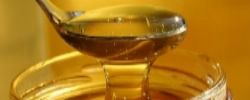Honeybee Body Wash

Bees are one of the most industrious insects around. One of the many ways bees help people is by making honey. Raw honey has numerous beneficial attributes, to include skin and hair maintenance, which is the focus of this article. The following recipe can help balance out all skin types and moisturize dry hair. Your skin and hair will have a beautiful sheen, and feel soft and smooth all day.
It is important to remember that you want to use raw, local honey and not store bought honey. Raw honey contains essential enzymes that are killed off in the pasteurizing process, which is a mandated condition for honey sold in United States grocery stores. Without the active enzymes, honey is just another sweetener and provides little value to your skin or hair.
This recipe is simple and can be adjusted in volume by increasing proportional parts. Here is how to make it.
Items Needed:
The honeybee body wash is most successful when the coconut oil is solidified. This is best achieved by storing coconut oil in the refrigerator. Coconut oil liquefies at approximately 72° F (22° C). While it is possible to make the body wash with liquefied coconut oil, it is more of a hassle, for an otherwise easy task. Coconut oil looks clear when in liquid form and white when solidified. Take your clean glass jar and fill it with the following:
To wash skin, use hot water to open the pores. For added healing benefits, allow the honeybee body wash to stay on your skin for 5 to 10 minutes. Honey can help heal scars, acne, balance skin conditions, smooth out rough spots, and assists in providing an even skin tone. In addition to being a natural moisturizer, honey is an antiseptic and works well on healing mild burns and abrasions.
For use on dry or damaged hair, thoroughly wet hair in hot water and allow the honeybee body wash to stay on your hair for 5 to 10 minutes, then rinse. For those with long hair, apply from mid-section down to tips and then apply to the top of head as needed.
To find raw honey distributors in the United States, Canada, or Germany, browse the Honey Locator.
It is important to remember that you want to use raw, local honey and not store bought honey. Raw honey contains essential enzymes that are killed off in the pasteurizing process, which is a mandated condition for honey sold in United States grocery stores. Without the active enzymes, honey is just another sweetener and provides little value to your skin or hair.
This recipe is simple and can be adjusted in volume by increasing proportional parts. Here is how to make it.
Items Needed:
- Clean Glass Jar with Lid
- Raw Local Honey
- Coconut Oil
- Baking Soda
- Tea Tree Essential Oil (optional)
The honeybee body wash is most successful when the coconut oil is solidified. This is best achieved by storing coconut oil in the refrigerator. Coconut oil liquefies at approximately 72° F (22° C). While it is possible to make the body wash with liquefied coconut oil, it is more of a hassle, for an otherwise easy task. Coconut oil looks clear when in liquid form and white when solidified. Take your clean glass jar and fill it with the following:
- 1Tbsp (15ml) Solidified Coconut Oil
- 1 Tbsp (15ml) Raw Honey
- 1 or 2 tsp (5 to 10ml) of Baking Soda
- 1 drop of Tea Tree Essential Oil (optional)
To wash skin, use hot water to open the pores. For added healing benefits, allow the honeybee body wash to stay on your skin for 5 to 10 minutes. Honey can help heal scars, acne, balance skin conditions, smooth out rough spots, and assists in providing an even skin tone. In addition to being a natural moisturizer, honey is an antiseptic and works well on healing mild burns and abrasions.
For use on dry or damaged hair, thoroughly wet hair in hot water and allow the honeybee body wash to stay on your hair for 5 to 10 minutes, then rinse. For those with long hair, apply from mid-section down to tips and then apply to the top of head as needed.
To find raw honey distributors in the United States, Canada, or Germany, browse the Honey Locator.
You Should Also Read:
Honeybees Reject Pollen
Monsanto Linked to Bee Plight
Helping Honeybees Benefits Your Garden

Related Articles
Editor's Picks Articles
Top Ten Articles
Previous Features
Site Map
Follow @WildlifeWelfare
Tweet
Content copyright © 2023 by Deb Duxbury. All rights reserved.
This content was written by Deb Duxbury. If you wish to use this content in any manner, you need written permission. Contact Deb Duxbury for details.







